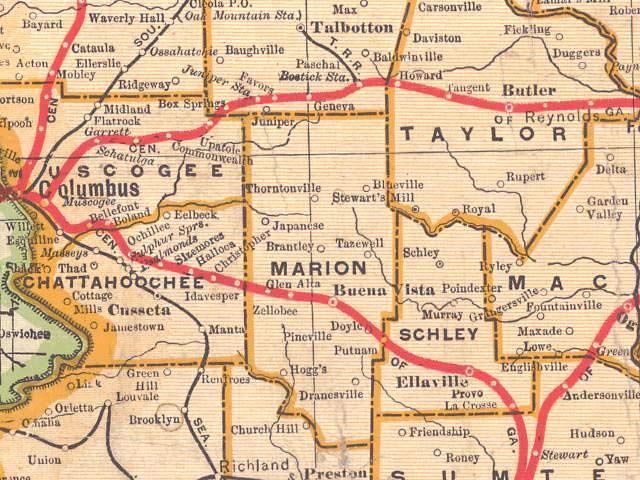1. Buena Vista Town Square
Marion County was named after the Revolutionary War hero General Francis “Swamp Fox” Marion. One of the most striking features of this county was its rapid population growth. Established in 1827, the 1850 census showed it was home to 10,000 residents. What explains this remarkable growth?

Marion County, 1899. Source: Central of Georgia Railway Map of Alabama and Georgia, 1899.
Newly accessible after the signing of the 1805 Treaty of Washington, western Georgia quickly opened up to immigration of cotton planters. Though Sea Island cotton, a long-staple cotton, thrived in the temperate climate of coastal Georgia, it was not appropriate for the more extreme climate of western Georgia. Short-staple cotton, introduced to Georgia in the 1790s, was well-matched to the flat, rich soils of counties along the fall line – the boundary between the coastal plain and the Piedmont, which runs between Augusta in the north east and Columbus in central west Georgia. However, short-staple cotton required far more labor to harvest than its Island cousin. Marion County planters quickly began importing slave labor to clear the region’s longleaf pine forests, as well as to plant and harvest cotton. By 1850, the remarkable success of the plantation economy accounted for the rapid expansion of population with just over 10,000 residents in the county, a third of whom were enslaved. This rapid success gave way to the birth of various small communities as this 1899 map indicates, including: Church Hill, Glen Alta (the birth place of the future St. EOM), Dranesville, Japanese, Juniper, Thorntonville, and Zellobee. By 1850, Buena Vista was chosen as the new central site for the county’s seat of government. Beginning at the heart of the county, we will visit several of these former communities on our tour. However, today you will see few cotton fields as much of the county has re-focused on timber production.
Submission composed by Amanda Rees, April 30, 2016.
References and Further Reading
Giesen, J. C. “Cotton,” New Georgia Encyclopedia, 2016.
Georgia Historical Society. No date. Plantation Economy. http://georgiahistory.com/education-outreach/online-exhibits/online-exhibits/encounter-and-exchange/a-new-encounter-black-slaves-in-georgia/plantation-economy/
